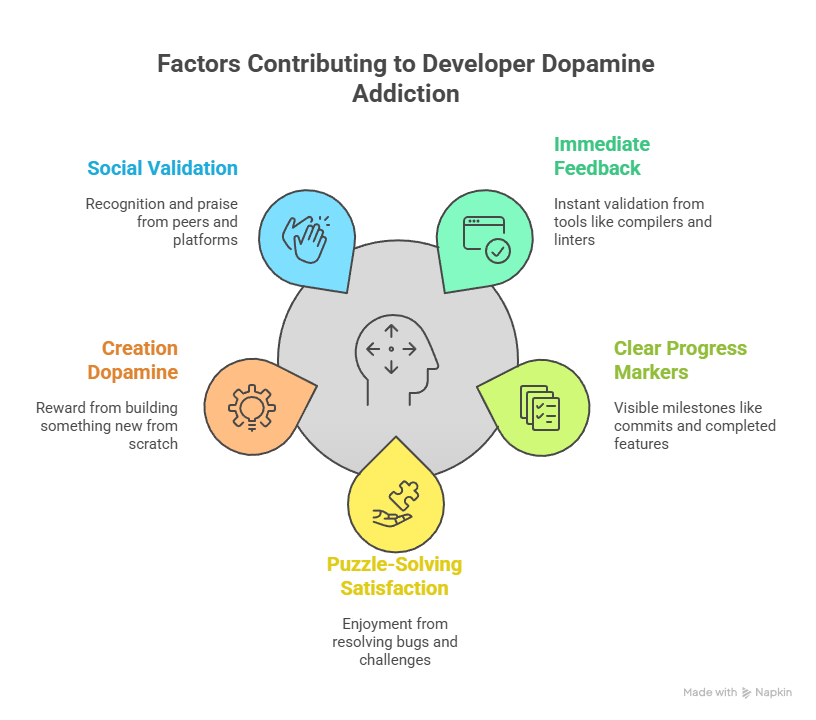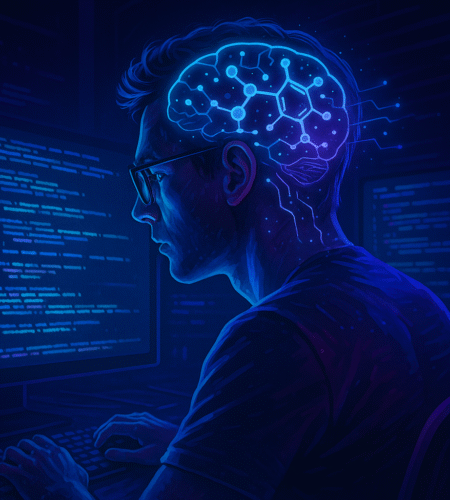The neuroscience behind why you can’t stop coding at 2 AM—and how to use it to supercharge your career
Picture this: It’s 11 PM. You tell yourself you’ll just fix “one more bug.” Fast forward to 3 AM, and you’re still hunched over your keyboard, eyes burning, but somehow unable to stop. Sound familiar? Congratulations—you’ve experienced the developer’s dopamine trap firsthand.
As software developers, we’re unknowingly participants in one of the most sophisticated neurochemical experiments ever conducted. Every line of code we write, every test that passes, every bug we squash is triggering a complex cascade of brain chemistry that can either make us incredibly productive… or completely burn us out.
The Neuroscience of Coding: Dopamine in Your IDE
Dopamine isn’t just the “pleasure chemical”—it’s the brain’s reward prediction system. And programming? It’s basically dopamine delivery on steroids.
Here’s what happens in your brain every time you code:
The Anticipation Phase: You encounter a problem. Your brain releases a small hit of dopamine in anticipation of solving it. This isn’t happiness—it’s focused motivation.
The Struggle: As you work through the problem, dopamine levels fluctuate. Each small breakthrough (a successful compile, a test passing, understanding a complex function) provides micro-rewards that keep you engaged.
The Victory: When you finally solve the problem, your brain floods with dopamine. The bigger the challenge, the bigger the reward. This is why fixing a bug that’s been haunting you for days feels so incredibly satisfying.
But here’s where it gets interesting—and potentially dangerous.
Why Developer Dopamine Addiction Peaks in Programming
Software development creates what neuroscientists call “variable ratio reinforcement”—the same mechanism that makes gambling addictive. You never know exactly when you’ll get your next “win,” but you know it’s coming. Sometimes you solve a problem in minutes. Sometimes it takes hours. This unpredictability makes the reward even more powerful.
Consider the typical development workflow:
- Immediate feedback loops: Compilers, linters, and tests provide instant validation
- Clear progress markers: Commits, completed features, closed issues
- Puzzle-solving satisfaction: Every bug is a mystery to solve
- Creation dopamine: Building something from nothing activates deep reward pathways
- Social validation: Code reviews, stars on GitHub, praise from teammates

No wonder developers often work late into the night or find it hard to step away from an engaging problem!
The Dark Side of Dopamine for Developers
But this dopamine-driven development cycle has a shadow side that’s rarely discussed in our industry.
The Fragmented Attention Crisis
Modern development environments are dopamine chaos. Slack notifications every few minutes. Email alerts. GitHub notifications. Code review requests. Meeting reminders. Each interruption provides a tiny dopamine hit, but collectively they’re destroying our ability to focus deeply.
Research shows it takes an average of 23 minutes to regain focus after an interruption. For developers, this means we’re rarely experiencing the deep, sustained focus states where our best work happens.
The Comparison Trap
Social media and professional platforms create unhealthy dopamine competition. Seeing colleagues’ promotions, successful side projects, or technical achievements on LinkedIn triggers social comparison—a powerful dopamine driver that often leads to anxiety and imposter syndrome rather than motivation.
The Endless Dopamine Chase
Some developers become “technology magpies,” constantly chasing the dopamine hit of learning new frameworks, tools, or languages. While learning is valuable, this can prevent deep mastery and create a cycle of perpetual beginner syndrome.
Overcoming Developer Burnout from Dopamine Dysregulation
Chronic overstimulation of dopamine pathways leads to tolerance—you need bigger and bigger wins to feel satisfied. This is why many successful developers report feeling empty after major project completions or why some find themselves unable to enjoy simple coding tasks that once brought satisfaction.
Signs your dopamine system might be dysregulated:
- Difficulty starting simple tasks
- Procrastination followed by intense work sessions
- Feeling unmotivated despite career success
- Needing increasingly complex challenges to feel engaged
- Anxiety when not actively working on stimulating problems
Hacking Your Dopamine for Sustainable Success
The good news? Understanding your brain’s reward system allows you to optimize it. Here’s how top developers are learning to work with their neurochemistry, not against it:
1. Design Your Own Reward Architecture
Micro-celebrations: Consciously acknowledge small wins. Finished a function? Take a moment to appreciate it. Fixed a tricky bug? Do a little mental victory dance. This isn’t silly—it’s neuroscience.
Progress visualization: Use tools that make your progress tangible. GitHub’s contribution graph isn’t just vanity—it provides visual evidence of consistent effort, which reinforces positive habits.
Structured goal-setting: Break large projects into dopamine-sized chunks. Instead of “build the authentication system,” try “implement user registration endpoint” → “add password validation” → “create login flow.”
2. Protect Your Focus Like It’s Sacred
Notification detox: Batch check messages at designated times. Your brain will initially resist this (it wants those micro-dopamine hits), but sustained focus provides much deeper satisfaction.
Deep work blocks: Schedule 2-4 hour blocks for complex problems. Turn off all notifications. Tell your brain it’s safe to go deep because interruptions aren’t coming.
Context switching costs: Limit yourself to 2-3 major contexts per day. Jumping between projects fragments your dopamine reward cycles and reduces satisfaction.
3. Optimize Your Development Environment
Reduce friction: Set up your development environment to minimize cognitive load. The faster you can go from idea to implementation, the tighter your dopamine feedback loops.
Visual progress: Use tools that show visual progress—test coverage reports, build status indicators, project completion dashboards. Your brain loves visual evidence of advancement.
Automate the boring stuff: Automate repetitive tasks not just for efficiency, but for dopamine preservation. Save your brain’s reward capacity for creative problem-solving.
4. Balance Challenge and Capability
The Goldilocks Zone: Tasks that are too easy provide minimal dopamine. Tasks that are too hard provide delayed or absent rewards. Aim for challenges that stretch you but remain achievable.
Skill building ladder: Deliberately structure your learning so each new concept builds on previous dopamine-rewarded successes. This creates positive momentum.
Pair challenging work with easier tasks: Follow complex problem-solving with simpler, more immediately rewarding work to maintain dopamine balance.
The Social Dopamine Factor
Programming might seem solitary, but the social aspects significantly impact our reward systems:
Code reviews as positive reinforcement: Frame code reviews as learning opportunities rather than judgment. Positive feedback triggers powerful social dopamine pathways.
Mentoring for double dopamine: Teaching others provides dopamine both from helping (social reward) and from reinforcing your own knowledge (mastery reward).
Collaborative problem-solving: Pair programming and collaborative debugging create shared dopamine experiences that are often more satisfying than solo victories.
Long-term Dopamine Health for Developers
Sustainable development careers require long-term thinking about reward systems:
Build Intrinsic Motivation
Connect to purpose: Regularly remind yourself how your work impacts users, colleagues, or causes you care about. Purpose-driven work creates more sustainable dopamine patterns than purely technical challenges.
Mastery over novelty: While new technologies provide excitement, deep mastery of core concepts provides longer-lasting satisfaction and career stability.
Growth mindset: Frame failures and bugs as learning opportunities rather than defeats. This maintains positive dopamine associations with challenging work.
Protect Against Dopamine Depletion
Regular breaks: Not just for your body, but for your reward systems. Take walks, meditate, or engage in completely different activities to reset your neurochemistry.
Sleep hygiene: Poor sleep destroys dopamine regulation. Prioritize 7-9 hours of quality sleep to maintain optimal brain function.
Exercise: Physical activity naturally regulates dopamine and provides a healthy outlet for stress and frustration.
Mindful consumption: Be intentional about social media, news, and other high-stimulation, low-value dopamine sources that can dysregulate your reward system.
The Future Developer: Neurochemically Optimized
The most successful developers of the future won’t just be those who can code—they’ll be those who understand how to optimize their brain’s reward systems for sustained creativity, focus, and satisfaction.
This means:
- Designing work environments that support deep focus
- Building habits that maintain healthy dopamine regulation
- Choosing projects and career paths that provide intrinsic motivation
- Creating social and professional networks that reinforce positive growth
Your Action Plan: Starting Tomorrow
- Track your dopamine patterns: For one week, notice when you feel most motivated and satisfied during coding. What types of problems energize you? What drains you?
- Audit your interruptions: Count how many times you’re interrupted or distracted during focused work. Each interruption is a dopamine hijack.
- Design your ideal work block: Create a 2-hour period with zero interruptions dedicated to your most challenging work. Notice how this feels compared to fragmented coding sessions.
- Celebrate systematically: Consciously acknowledge three small wins each day. Train your brain to notice progress.
- Protect your off-time: Engage in activities that restore rather than further stimulate your dopamine system.
The Bottom Line
Understanding the neuroscience behind programming doesn’t diminish the craft—it enhances it. By working with your brain’s natural reward systems rather than against them, you can maintain the joy and satisfaction that drew you to coding in the first place while building a sustainable, fulfilling career.
Your brain is your most important development tool. It’s time to start optimizing it as carefully as you optimize your code.
What dopamine patterns have you noticed in your own coding? Share your experiences and strategies in the comments below.


Comments